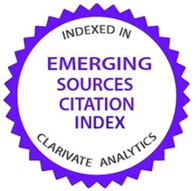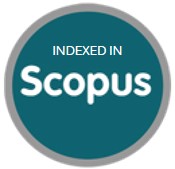La tríada oscura de la personalidad: maquiavelismo, narcisismo y psicopatía. Una mirada evolutiva
DOI:
https://doi.org/10.47741/17943108.150Palabras clave:
personalidad, psicología, psicópata, psicopatología, violenciaResumen
Se aborda la denominada Tríada Oscura de la Personalidad –Tríada– (maquiavelismo, narcisismo subclínico y psicopatía subclínica) desde una mirada evolutiva. El objetivo de esta investigación es revisar la evidencia que han presentado los teóricos evolucionistas sobre la Tríada, desde un acercamiento a la mirada evolutiva. Para esto, se indaga en las principales características de cada uno de estos rasgos, los instrumentos que se han utilizado para evaluarlos y las principales áreas en donde se han estudiado. La mirada evolutiva plantea que los rasgos de la Tríada son dimensionales y varían de acuerdo con las diversas estrategias que utilizan los sujetos para adaptarse a las características socioambientales en las que se desarrollan. Estos rasgos se caracterizan por presentar violencia psicológica, inhibición moral, manipulación, baja amabilidad, insensibilidad, egoísmo y dificultad para mentalizar en contextos de interacción interpersonal y social.
Descargas
Referencias
Ames, D. R., Rose, P. & Anderson, C. P. (2006). The NPI-16 as a short measure of narcissism. Journal of Research in Personality, 40 (4): 440-450.
Austin, E. J., Farrelly, D., Black, C. & Moore, H. (2007). Emotional intelligence, Machiavellianism and emotional manipulation: Does EI have a dark side? Personality and Individual Differences, 43 (1): 179-189.
Baughman, H. M., Jonason, P. K., Lyons, M. & Vernon, P. A. (2014). Liar liar pants on fire: Cheater strategies linked to the Dark Triad. Personality and Individual Differences, 71: 35- 38.
Bernal, A. O. (1987). Maquiavelismo y sociedad contemporánea: una perspectiva psicosocial de la personalidad maquiavélica. Revista Pedagógica (3): 95-107.
Black, P. J., Woodworth, M. & Porter, S. (2014). The Big Bad Wolf? The relation between the Dark Triad and the interpersonal assessment of vulnerability. Personality and Individual Differences, 67: 52-56.
Cabrera, J., Gallardo, R., González, F. R. & Navarrete, R. (2014). Psicopatía y delincuencia: comparaciones y diferencias entre ofensores sexuales y delincuentes comunes en una cárcel chilena. Revista Criminalidad, 56 (2): 229-245.
Cairncross, M., Veselka, L., Schermer, J. A. & Vernon, P. A. (2013). A behavioral genetic analysis of alexithymia and the Dark Triad traits of personality. Twin Research and Human Genetics, 16 (03): 690-697.
Carter, G. L., Campbell, A. C. & Muncer, S. (2014a). The Dark Triad: Beyond a ‘male’ mating strategy. Personality and Individual Differences, 56: 159-164.
Carter, G. L., Campbell, A. C. & Muncer, S. (2014b). The Dark Triad personality: Attractiveness to women. Personality and Individual Differences, 56: 57-61.
Christie, R. & Geis, F. L. (1970). Studies in Machiavellianism. New York: Academic Press.
Cleckley, H. (1988). The mask of sanity (5th Ed.). St.Louis, MO: Mosby, Co.
Costa Jr., P. T., McCrae, R. R. & Dye, D. A. (1991). Facet scales for agreeableness and conscientiousness: a revision of the NEO personality inventory. Personality and Individual Differences, 12 (9): 887-898.
Crysel, L. C., Crosier, B. S. & Webster, G. D. (2013). The Dark Triad and risk behavior. Personality and Individual Differences, 54 (1): 35-40.
Darwin, C. (1859). On the Origin of Species by Means of Natural Selection, or The Preservation of Favoured Races in the Struggle for Life. London/Die Entstehung der Arten durch natürliche Zuchtwahl, Leipzig o.J.
Djeriouat, H. & Trémolière, B. (2014). The Dark Triad of personality and utilitarian moral judgment: the mediating role of Honesty/Humility and Harm/Care. Personality and Individual Differences, 67: 11-16.
Fehr, B., Samsom, D. & Paulhus, D. L. (1992). The construct of Machiavellianism: Twenty years later. In C. D. Spielberger & J. N. Butcher (Eds.). Advances in personality assessment (Vol. 9, pp. 77-116). Hillsdale, NJ: Erlbaum.
Furnham, A., Richards, S. C. & Paulhus, D. L. (2013). The Dark Triad of personality: A 10 year review. Social and Personality Psychology Compass, 7 (3): 199-216.
Furnham, A., Richards, S., Rangel, L. & Jones, D. N. (2014). Measuring malevolence: Quantitative issues surrounding the Dark Triad of personality. Personality and Individual Differences, 67: 114-121.
Garcia, D. & Sikström, S. (2014). The dark side of Facebook: Semantic representations of status updates predict the Dark Triad of personality. Personality and Individual Differences, 67: 92-96.
Giammarco, E. A. & Vernon, P. A. (2014). Vengeance and the Dark Triad: The role of empathy and perspective taking in trait forgivingness. Personality and Individual Differences, 67: 23-29.
Goncalves, M. K. & Campbell, L. (2014). The Dark Triad and the derogation of mating competitors. Personality and Individual Differences, 67: 42-46.
Gruys, M. L. & Sackett, P. R. (2003). Investigating the dimensionality of counterproductive work behavior. International Journal of Selection and Assessment, 11 (1): 30-42.
Hare, R. D. (1991). The Hare Psychopathy Checklist-Revised. Toronto: Multi-Health Systems.
Hare, R. D. (2003). Manual for the Revised Psychopathy Checklist (2nd Ed.). Toronto, ON, Canada: Multi-Health Systems.
Huseman, R. C., Hatfield, J. D. & Miles, E. W. (1987). A new perspective on equity theory: The equity sensitivity construct. Academy of Management Review, 12 (2): 222-234.
James, S., Kavanagh, P. S., Jonason, P. K., Chonody, J. M. & Scrutton, H. E. (2014). The Dark Triad, schadenfreude, and sensational interests: Dark personalities, dark emotions, and dark behaviors. Personality and Individual Differences, 68: 211-216.
Jonason, P. K., Jones, A. & Lyons, M. (2013). Creatures of the night: Chronotypes and the Dark Triad traits. Personality and Individual Differences, 55 (5): 538-541.
Jonason, P. K. & Krause, L. (2013). The emotional deficits associated with the Dark Triad traits: Cognitive empathy, affective empathy, and alexithymia. Personality and Individual Differences, 55 (5): 532-537.
Jonason, P. K., Li, N. P., Webster, G. D. & Schmitt, D. P. (2009). The dark triad: Facilitating a short-term mating strategy in men. European Journal of Personality, 23 (1): 5-18.
Jonason, P. K., Lyons, M., Bethell, E. J. & Ross, R. (2013). Different routes to limited empathy in the sexes: Examining the links between the Dark Triad and empathy. Personality and Individual Differences, 54 (5): 572-576.
Jonason, P. K., Lyons, M., Baughman, H. M. & Vernon, P. A. (2014). What a tangled web we weave: The Dark Triad traits and deception. Personality and Individual Differences, 70: 117-119.
Jonason, P. K., Lyons, M. & Bethell, E. (2014). The making of Darth Vader: Parent–child care and the Dark Triad. Personality and Individual Differences, 67: 30-34.
Jonason, P. K., Webster, G. D., Schmitt, D. P., Li, N. P. & Crysel, L. (2012). The antihero in popular culture: Life history theory and the dark triad personality traits. Review of General Psychology, 16 (2): 192.
Jonason, P. K., Wee, S., Li, N. P. & Jackson, C. (2014). Occupational niches and the Dark Triad traits. Personality and Individual Differences, 69: 119-123.
Jones, D. N. (2013). What’s mine is mine and what’s yours is mine: The Dark Triad and gambling with your neighbor’s money. Journal of Research in Personality, 47 (5): 563-571.
Jones, D. N. (2014). Risk in the face of retribution: Psychopathic individuals persist in financial misbehavior among the Dark Triad. Personality and Individual Differences, 67: 109-113.
Jones, D. N. & Paulhus, D. L. (2009). Machiavellianism. In M. R. Leary & R. H. Hoyle (Eds.). Handbook of Individual Differences in Social Behavior (pp. 93–108). New York: Guilford.
Jones, D. N. & Paulhus, D. L. (2011). The role of impulsivity in the Dark Triad of personality. Personality and Individual Differences, 51 (5): 679-682.
Jones, D. N. & Paulhus, D. L. (2014). Introducing the Short Dark Triad (SD3): A Brief Measure of Dark Personality Traits. Assessment, 21 (1): 28-41.
Jones, D. N. & Weiser, D. A. (2014). Differential infidelity patterns among the Dark Triad. Personality and Individual Differences, 57: 20-24.
Lee, K. & Ashton, M. C. (2014). The Dark Triad, the Big Five, and the HEXACO model. Personality and Individual Differences, 67: 2-5.
Lilienfeld, S. O. & Andrews, B. P. (1996). Development and preliminary validation of a self-report measure of psychopathic personality traits in noncriminal populations. Journal of Personality Assessment, 66: 488-524.
McDonald, M. M., Donnellan, M. B. & Navarrete, C. D. (2012). A life history approach to understanding the Dark Triad. Personality and Individual Differences, 52 (5): 601-605.
Miller, J. D., Dir, A., Gentile, B., Wilson, L., Pryor, L. R. & Campbell, W. K. (2010). Searching for a vulnerable dark triad: Comparing factor 2 psychopathy, vulnerable narcissism, and borderline personality disorder. Journal of Personality, 78 (5): 1529-1564.
Morf, C. C. & Rhodewalt, F. (2001). Expanding the dynamic self-regulatory processing model of narcissism: Research directions for the future. Psychological Inquiry, 12 (4): 243-251.
Nagler, U. K., Reiter, K. J., Furtner, M. R. & Rauthmann, J. F. (2014). Is there a “dark intelligence”? Emotional intelligence is used by dark personalities to emotionally manipulate others. Personality and Individual Differences, 65: 47-52.
O’Boyle, E. H., Forsyth, D., Banks, G. C. & Story, P. A. (2013). A meta-analytic review of the Dark Triad–intelligence connection. Journal of Research in Personality, 47 (6): 789-794.
O’Connor, P. J. & Athota, V. S. (2013). The intervening role of Agreeableness in the relationship between Trait Emotional Intelligence and Machiavellianism: Reassessing the potential dark side of EI. Personality and Individual Differences, 55 (7): 750-754.
Pabian, S., De Backer, C. J. & Vandebosch, H. (2015). Dark Triad personality traits and adolescent cyber-aggression. Personality and Individual Differences, 75: 41-46.
Pailing, A., Boon, J. & Egan, V. (2014). Personality, the Dark Triad and violence. Personality and Individual Differences, 67: 81-86.
Paulhus, D. L. & Williams, K. M. (2002). The dark triad of personality: Narcissism, Machiavellianism, and psychopathy. Journal of Research in Personality, 36 (6): 556-563.
Porter, S., Bhanwer, A., Woodworth, M. & Black, P. J. (2014). Soldiers of misfortune: An examination of the Dark Triad and the experience of schadenfreude. Personality and Individual Differences, 67: 64-68.
Pozueco, J. M. & Moreno, J. M. (2013). Psicopatía, maquiavelismo, narcisismo y maltrato psicológico. Boletín de Psicología (107): 91-111.
Premack, D. & Woodruff , G. (1978). Does the chimpanzee have a theory of mind? Behavioral and Brain Sciences, 1 (4): 515-526.
Raskin, R. N. & Hall, C. S. (1979). A narcissistic personality inventory. Psychological Reports, 45 (2): 590-590.
Rauthmann, J. F. & Kolar, G. P. (2013). The perceived attractiveness and traits of the Dark Triad: Narcissists are perceived as hot, Machiavellians and psychopaths not. Personality and Individual Differences, 54 (5): 582-586.
Riquelme, E. H., Henríquez, C. & Álvarez, B. (2003). Relación entre estilos de apego y teoría de la mente. Psykhe, 12 (1): 73-81.
Scherer, K. T., Baysinger, M., Zolynsky, D. & LeBreton, J. M. (2013). Predicting counterproductive work behaviors with sub-clinical psychopathy: Beyond the Five Factor Model of personality. Personality and Individual Differences, 55 (3): 300-305.
Stellwagen, K. K. & Kerig, P. K. (2013). Dark triad personality traits and theory of mind among school-age children. Personality and Individual Differences, 54 (1): 123-127.
Van Dijk, W. W., van Koningsbruggen, G. M., Ouwerkerk, J. W. & Wesseling, Y. M. (2011). Self-esteem, self-affirmation, and schadenfreude. Emotion, 11 (6): 1445.
Veselka, L., Schermer, J. A. & Vernon, P. A. (2011). Beyond the Big Five: The dark triad and the supernumerary personality inventory. Twin Research and Human Genetics, 14 (2): 158- 168.
Webster, G. D. & Jonason, P. K. (2013). Putting the “IRT” in “Dirty”: Item Response Theory analyses of the Dark Triad Dirty Dozen–An efficient measure of narcissism, psychopathy, and Machiavellianism. Personality and Individual Differences, 54 (2): 302-306.
Williams, K. M., Spidel, A. & Paulhus, D. L. (2005). Sex, lies, and more lies: Exploring the intimate relationships of subclinical psychopaths. In meeting of the Society for the Scientific Study of Psychopathy, Vancouver, BC.
Woodley, H. J. & Allen, N. J. (2014). The dark side of equity sensitivity. Personality and Individual Differences, 67: 103-108.
Zuckerman, M. (1994). Behavioral expressions and biosocial bases of sensation seeking. Cambridge University Press.





















